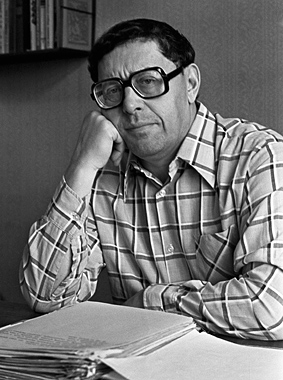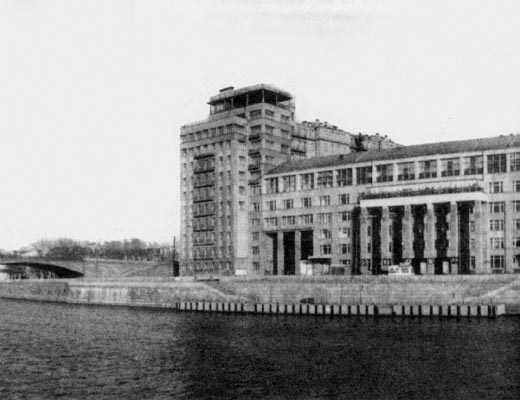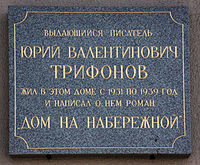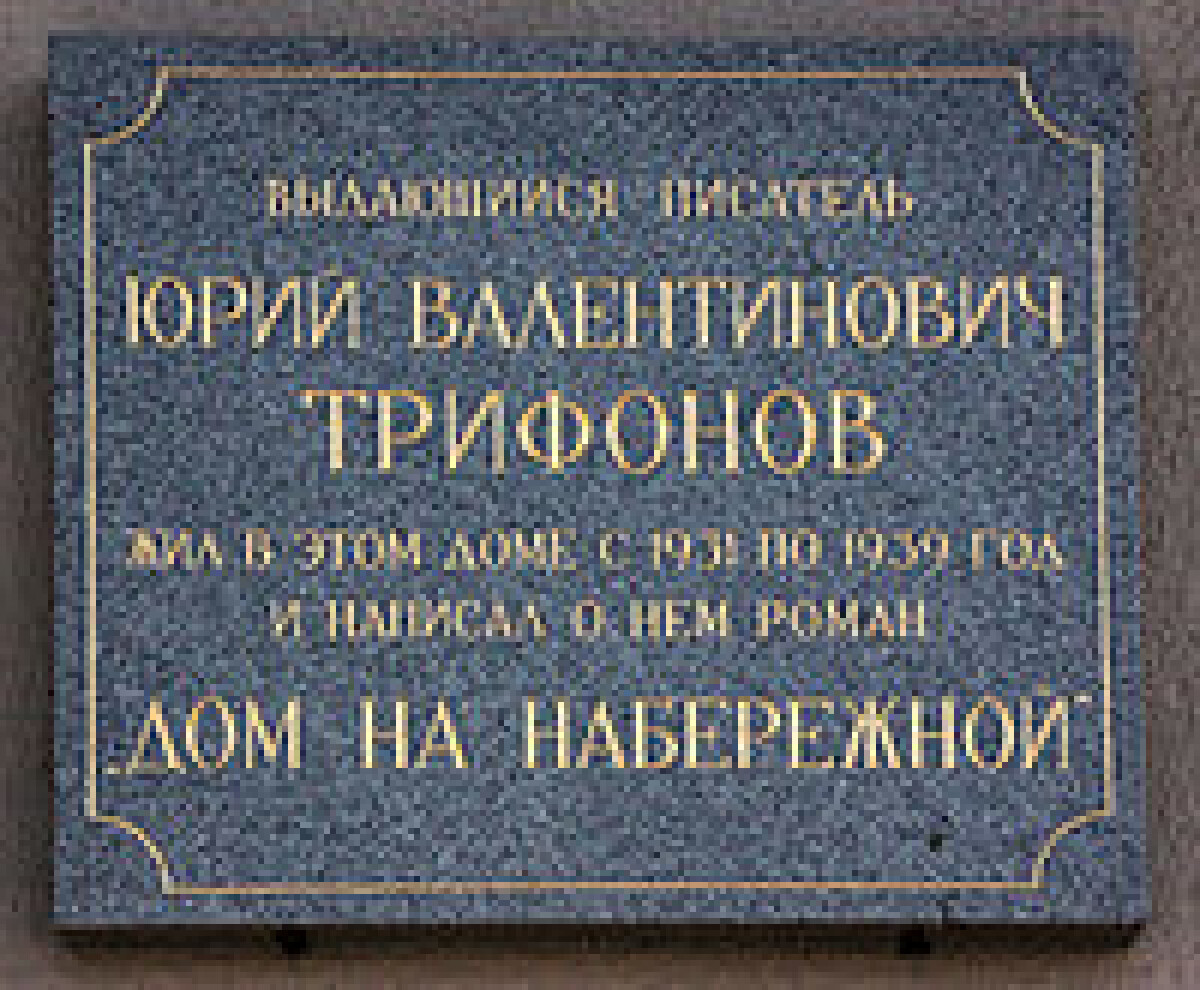
One of the most outstanding masters of the fiction belles-lettres prose of 60-70-ies of the 20 century. His name involves the beginning of a new era in the history of Kazak-Russian literature. A native of Moscow, during the Great Patriotic Second World War he studied in Taskent, and later returned to his hometown, where he worked on aviation plant. While he was a student in 1947 year Trifonov published his first stories.
The literary skills by young, aspiring novelist Trifonov was studied from older generation: K. Fedin, K. Paustovsky. About this period of the life writer Trifonov also remembers that: "Seminars of Paustovsky gave us a lot. It's not about any specific analyses, words, examples, or rather, not only in the air, which we imbibed. If you’ll do not fear the high-sounding words, you can say: it was the air of force and purity ".
Software work of “urban prose” of Trifonov is his story “House on the embankment”. This piece is interesting in that it is the central imago is the House, rather than any living person. Imago of the House in the Trifonov’s novel “House on the embankment” difficult complex imago, multifunctional, shares in itself the aspirations and dreams of the protagonist/main hero. Trifonov’s House on embankment is how Igor Volgin says, “dream-house”, “Ma'am-house” and “death- house”. For Trifonov there was stood large-scale, challenge - to focus in the same way of life and the fate of an entire generation, realized that “revolution is in vain” (Leo Anninsky) that they are tools, working material of everywhere forming by conformism. Imago of the House is Central, and all other imagoes only arranged around it, only complementing and completing the picture.
“Gray, a huge, like a city or even a whole country, a House with thousand Windows” House on embankment by its architecture (“squat, formless, long”) and by color scheme (“grey”) it’s similar to St Petersburg houses of F.M. Dostoevsky. Trifonov’s House is like the entire Soviet Union, it also covers almost all the fiction art space of the story, even when the characters are in a different place, because it is the country, comprehensive and inclusive.

Exactly “The House on the embankment” itself
From the outset, the House on the embankment leads Glebov, and at the same time, his (House) “curve-sided beauty” tread out, fertile imagination of generated suffering from “mismatch” (comparing with painful moods of Dostoyevsky heroes, who is the inhabitants of the same grey houses). Yuri Trifonov focuses the reader’s accent exactly on the “grayness” of the House on the embankment, because it’s not the randomly his characterization begins just with the color.
If we analyse the symbolism of the gray House on the embankment, tracing its most important features and their presence in the literary art works of Kazak-Russian literature, then we’ll come to the following conclusions. Grey is the colour of poverty, boredom and angst, the urban tightness, rotten fog (comparing to describing of Glebov’s house: “it’s slightly crooked House with Brown plaster”). In antiquity and the “Middle Ages” it was not valued. It was considered as a color of massacre of poverty and poor people, as a colour of misery and mediocrity. Blue-gray color of the ancient Romans symbolized the envy (comparing: “and Glebov has the minority of a soul since his childhood: envy, or something else”). In the ancient East strewed the head of dead by ashes as a sign of mourning.
Glebov’s suffering from “mismatch” was a direct continuation of the let it be and much richer, but still gray, unhappy, and this initially unavailable House on the embankment. This is House and there's a whole country, as stated previously, consisting of different people ranging from here and helpful lifters - conformists who “always looked suspicious”, and brilliant people like Anton Ovchinnikov, who was “a fan of Verdi's Opera “Aida” could sing from memory full, from beginning to end”.

A memorial plaque on the wall of “the House on the embankment”.
And while Glebov became older, then more he gets used to it to House (rising of conformism and moral indifference?), because “you can get used to everything”. But he did not become “their own person” because he’s belonged to a “special breed of Heroes: ready to hunker down at the crossroads as long as possible, until the final seconds when people drop dead from exhaustion. Hero-waiter, hero-drag outer. From those, who are not solving who is provides to solve to his horse”. Noteworthy in this regard, saying the following excerpt: “manners and modesty of huge Shepherd surprised Glebov, and at the same time, in her not blinking eyes seems calm him nut superiority: because it was the occupant of this House, and he was only a guest. He wanted to Pat the dog. A spontaneous impulse, naive movement of child memory. He stretched out his hand, but the dog, grumbled, pulled the muzzle and clattering by teeth. “It is impossible! You can’t! Stand at attention! -It was written on a black arrogant face of dog -The fact that you allowed to enter this House and you are you traveling and riding in the elevator, doesn't mean you're here “their own person”.
And in connection with the dogs in the elevator, which is, in fact, a metaphor of "foreignness" Glebov, there is another interpretation of the image of the House on the waterfront-home as a symbol of power. Each inhabitant of the House on the waterfront has a share of power. Sulepa, for example, reigns supreme in the classroom, Professor-University Alliance International indisputable authority (of course, for the time being, but still), even Anton Ovchinnikov, with all the modesty of their material status, you could say, holds sway over the minds of his fellow, even without realizing it. In the power of a certain system, hierarchy, and the "big grey House, Shadow Lane, it is present. Life, argues N.V. Ivanov in his monograph, too stratified, "following the floor hierarchy". One thing-a huge apartment Sulepnikov, in the hallway where you can and on the bike ride, so it is huge. This is a special, incredible for Glebov social world, in which "the cake may be stale. Just below-family Ganchukov, whose apartment is not similar to a flat Sulepnikov's, but not without its charms for Glebov. Falls even lower: on the ground floor of a large House, a modest little flat lives the most gifted of Anton, boys, the same owner, knowledgeable minds "Aida" by Verdi. It's simple, commonplace: clean poverty, prison furniture, portrait of the deceased father on the wall.
And yet, with all the pain of "irregularities", the House on the embankment was to focus his dream of Glebov well-being, even purely external. His attachment to the professorial family Ganchukov can explain that. Their apartment, their Habitat Wednesday-other social strata, different from family Levka Sulepnikov, but he's also Dan through perception Glebov. "Glebov liked the smell of carpets, old books, circle on the ceiling from a huge shade table lamp, like armored walls and books to the ceiling at the top in the number of soldiers, plaster is". Glebov from childhood dream to reach a situation in the very House on quay, not as a guest but as a host.

House on the seafront in our days
Big House and little define the boundaries of social claims and migrations Glebov. His childhood with gripping thirst reach another provision is not a guest, and, as has been said, the owner in the big house. With the House on the waterfront and with Deruginski farmstead relate those memories, through which young heroes of the story. Test how would portend something serious that children experience then: separation from parents, the harsh conditions of military life, death at the front.
With the disappearance of the House on the quay deliberately forgets everything and Glebov, not only surviving while the flood, but has reached the new prestigious peaks precisely because he "tried not to remember. What is not remembered, ceased to exist. " He lived "a life that wasn't," stresses Trifonov.
The fate of prose Trifonov can be called happy. It reads a country where book Trifonov had thirty years of impressive circulation; It translates and publishes the East and the West, Latin America and Africa. Thanks to the profound social specificity and him pictured nodal moments in Russian history he became interesting to readers around the world. Whatever wrote Trifonov-about people or about the civil war, he wanted to understand our time to pass his problems, address the causes of contemporary social phenomena. Life was perceived by him as single artistic process where everything is connected, everything rhymes. And "man is a thread that stretches through time, Superfine nerve history ...". This "history", making nerve pain, felt myself and stayed for us Yuri Trifonov.
To copy and publish materials, you must have written or oral permission from the editorial board or the author. A hyperlink to the Adebiportal.kz portal is required. All rights reserved by the Law of the Republic of Kazakhstan "On Copyright and Related Rights". adebiportal@gmail.com 8(7172) 57 60 14 (in - 1060)
The opinion of the author of the article does not represent the opinion of the editorial board.




